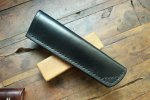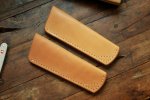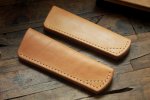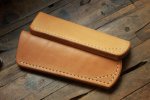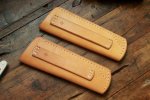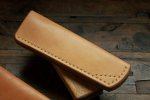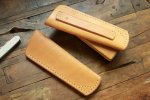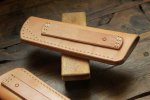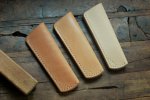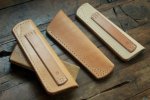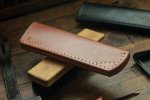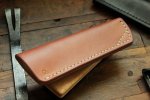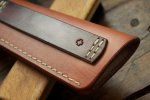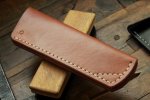Nice work!!! All look great!!
-
The BladeForums.com 2024 Traditional Knife is ready to order! See this thread for details: https://www.bladeforums.com/threads/bladeforums-2024-traditional-knife.2003187/
Price is$300$250 ea (shipped within CONUS). If you live outside the US, I will contact you after your order for extra shipping charges.
Order here: https://www.bladeforums.com/help/2024-traditional/ - Order as many as you like, we have plenty.
You are using an out of date browser. It may not display this or other websites correctly.
You should upgrade or use an alternative browser.
You should upgrade or use an alternative browser.
Photos Swiss Heritage Co. (work progress thread)
- Thread starter SwissHeritageCo
- Start date
SwissHeritageCo
Knifemaker / Craftsman / Service Provider
- Joined
- Jan 8, 2021
- Messages
- 3,430
Some fine work!!!!! Nice job!!!!
SwissHeritageCo
Knifemaker / Craftsman / Service Provider
- Joined
- Jan 8, 2021
- Messages
- 3,430
Horsewright
Knifemaker / Craftsman / Service Provider
- Joined
- Oct 4, 2011
- Messages
- 13,583
Yes they will, very nice!Au naturel with a neatsfoot oil finish, these should patina nicely.
View attachment 2340746
View attachment 2340747
View attachment 2340754
View attachment 2340750
View attachment 2340751
View attachment 2340752
View attachment 2340753
View attachment 2340756
View attachment 2340755
SwissHeritageCo
Knifemaker / Craftsman / Service Provider
- Joined
- Jan 8, 2021
- Messages
- 3,430
This one was hot waxed to it's saturation point,
View attachment 2359680
View attachment 2359681
View attachment 2359682
View attachment 2359683
Very nice work!!!!
Box_Opener
Gold Member
- Joined
- Aug 21, 2018
- Messages
- 937
This is very precise, clean work. Nowhere to hide on this one. I love it. I'll have to get a sheath from you soon.
Horsewright
Knifemaker / Craftsman / Service Provider
- Joined
- Oct 4, 2011
- Messages
- 13,583
Very clean! Excellent work. Sometimes you crease the throat and sometimes no?This one was hot waxed to it's saturation point,
View attachment 2359680
View attachment 2359681
View attachment 2359682
View attachment 2359683
SwissHeritageCo
Knifemaker / Craftsman / Service Provider
- Joined
- Jan 8, 2021
- Messages
- 3,430
Very clean! Excellent work. Sometimes you crease the throat and sometimes no?
is that what the folded side is called? I gouge a channel in it every time yes, because bizarrely if I don't it seems to affect the retention (that's my theory at least). For me personally, also kind of depends on how hard the leather is tempered, I'd definitely prefer not to have to get it really wet if possible because I've had the water bleed through and change the way the dye absorbs. Also a wet sheath is difficult to punch and not stretch/deform.
I say all of this after scouring over your amazing time saving tips lol, because I'm super slow.
Horsewright
Knifemaker / Craftsman / Service Provider
- Joined
- Oct 4, 2011
- Messages
- 13,583
Sorry late getting back to ya. Tied up.
Anyhoo a crease is a decorative line along an unsewn edge like ya did above on this black sheath at the throat. There are special tools made to do this with or as you did or at least it kinda looks like ya did with your groover. I use a groover too on a certain project but most of the time I use a creaser. These come in different styles and shapes from a freehand one to adjustable ones. Osborne makes them in sizes like edge bevellers. Traditionally they were heated up over an alcohol burner or lamp and so the crease was kinda burnt in a little. This is seldom done these days. For the most part I feel that any un sewn edge should be creased. It, to my eye makes it more finished appearing. So to me this black one looks more finished than the tans ones further down. Its just a small thing but I think it makes a diff.
On the throat of this sheath:

Or this scabbard:

Course it does depend on the leather. I use to do it on the straps for scabbards too. But, when I switched to water buffalo for the straps I quit doing it on them. The water buffalo doesn't crease or tool well.
SwissHeritageCo
Knifemaker / Craftsman / Service Provider
- Joined
- Jan 8, 2021
- Messages
- 3,430
Sorry late getting back to ya. Tied up.
Anyhoo a crease is a decorative line along an unsewn edge like ya did above on this black sheath at the throat. There are special tools made to do this with or as you did or at least it kinda looks like ya did with your groover. I use a groover too on a certain project but most of the time I use a creaser. These come in different styles and shapes from a freehand one to adjustable ones. Osborne makes them in sizes like edge bevellers. Traditionally they were heated up over an alcohol burner or lamp and so the crease was kinda burnt in a little. This is seldom done these days. For the most part I feel that any un sewn edge should be creased. It, to my eye makes it more finished appearing. So to me this black one looks more finished than the tans ones further down. Its just a small thing but I think it makes a diff.
On the throat of this sheath:

Or this scabbard:

Course it does depend on the leather. I use to do it on the straps for scabbards too. But, when I switched to water buffalo for the straps I quit doing it on them. The water buffalo doesn't crease or tool well.
I was referring to the "throat" which I have been calling the mouth of the sheath lol
The choice to leave out a crease/groove of the throat for those natural sheaths was deliberate this time around because I'm attempting to emulate the style of the old swiss military saddlers which is a very specific clean look, the beauty is more derived from age/use/repeated treatments and part of that was making a sheath that holds it's form for a long time. Somehow I rationalized the groover away during that thought process lol.
Next one I make will be grooved! (or creased if that tiny attachment is any good). If it comes out looking weird I'm blaming you haha
Gary W. Graley
“Imagination is more important than knowledge"
Knifemaker / Craftsman / Service Provider
- Joined
- Mar 2, 1999
- Messages
- 27,663
Echoing the other folks, looks like nice neat workmanship there for sure.
As to the crease along the top, I use that as a definitive line of the sheath, gives it a more refined look, to me at least instead of just the wide expanse of leather trailing off. I use the bone folder end to go down into the cut groove to burnish that area giving it a more finished look.
Here you can see the bottom side hasn't been burnished yet and above is an area that I am burnishing, it deepens the groove and burnishes at the same time
 12 by GaryWGraley, on Flickr
12 by GaryWGraley, on Flickr
G2
As to the crease along the top, I use that as a definitive line of the sheath, gives it a more refined look, to me at least instead of just the wide expanse of leather trailing off. I use the bone folder end to go down into the cut groove to burnish that area giving it a more finished look.
Here you can see the bottom side hasn't been burnished yet and above is an area that I am burnishing, it deepens the groove and burnishes at the same time
 12 by GaryWGraley, on Flickr
12 by GaryWGraley, on FlickrG2
SwissHeritageCo
Knifemaker / Craftsman / Service Provider
- Joined
- Jan 8, 2021
- Messages
- 3,430
Echoing the other folks, looks like nice neat workmanship there for sure.
As to the crease along the top, I use that as a definitive line of the sheath, gives it a more refined look, to me at least instead of just the wide expanse of leather trailing off. I use the bone folder end to go down into the cut groove to burnish that area giving it a more finished look.
Here you can see the bottom side hasn't been burnished yet and above is an area that I am burnishing, it deepens the groove and burnishes at the same time
12 by GaryWGraley, on Flickr
G2
We're going to put this theory to this test and see if that line is truly more aesthetic or not! Personally, I find the throat groove a bit "meh", as in it looks like every other bushcraft style sheath but if the general consensus is pro throat groove I will happily oblige
I do think
Gary W. Graley
“Imagination is more important than knowledge"
Knifemaker / Craftsman / Service Provider
- Joined
- Mar 2, 1999
- Messages
- 27,663
Always a personal preference, I don't think there is a right or wrong way to make sheaths.
On my slip sheaths, since the leather is more flexible/softer I don't cut a groove line in, but use the creaser end of the bone folder to make that ridge like I did on this sheath
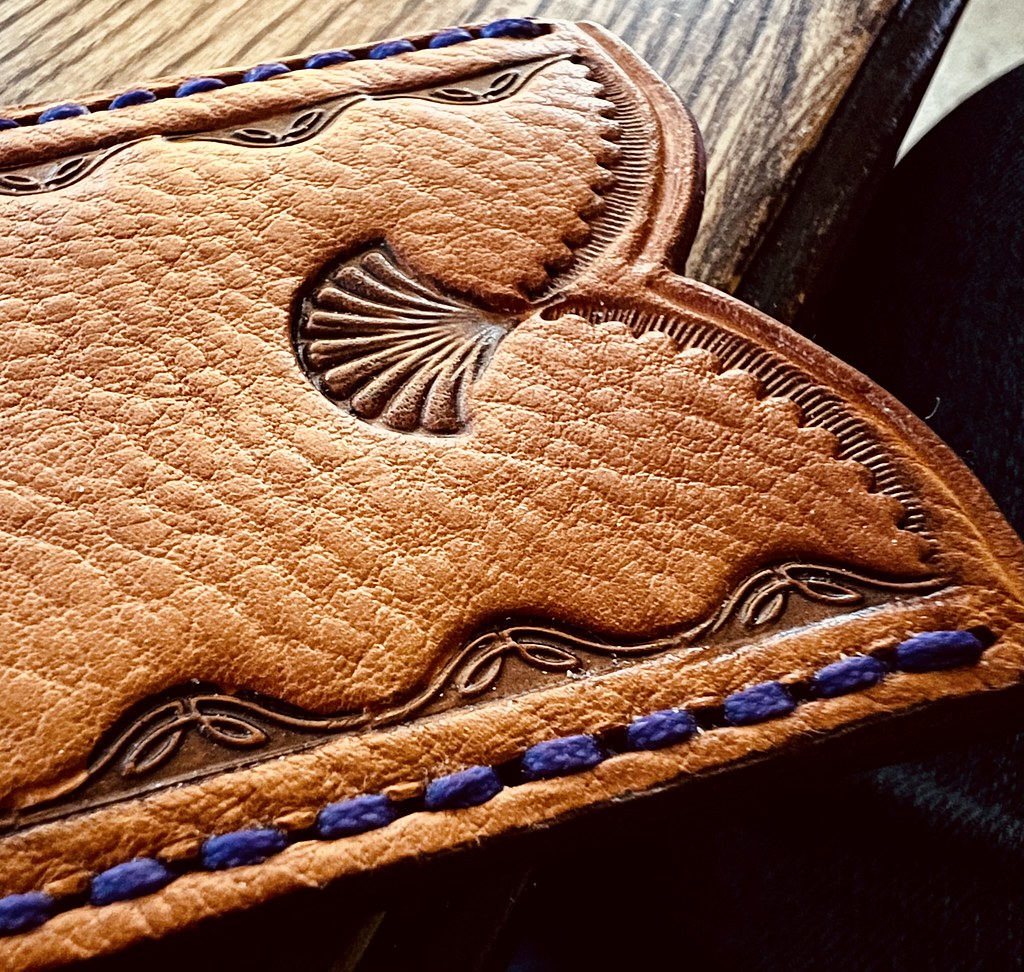 Untitled by GaryWGraley, on Flickr
Untitled by GaryWGraley, on Flickr
 54 by GaryWGraley, on Flickr
54 by GaryWGraley, on Flickr
G2
On my slip sheaths, since the leather is more flexible/softer I don't cut a groove line in, but use the creaser end of the bone folder to make that ridge like I did on this sheath
 Untitled by GaryWGraley, on Flickr
Untitled by GaryWGraley, on Flickr 54 by GaryWGraley, on Flickr
54 by GaryWGraley, on FlickrG2
SwissHeritageCo
Knifemaker / Craftsman / Service Provider
- Joined
- Jan 8, 2021
- Messages
- 3,430
Always a personal preference, I don't think there is a right or wrong way to make sheaths.
On my slip sheaths, since the leather is more flexible/softer I don't cut a groove line in, but use the creaser end of the bone folder to make that ridge like I did on this sheath
Untitled by GaryWGraley, on Flickr
54 by GaryWGraley, on Flickr
G2
There definitely is
Thanks again bud.
Horsewright
Knifemaker / Craftsman / Service Provider
- Joined
- Oct 4, 2011
- Messages
- 13,583
Yeah give er a try. It just kinda finishes a deal in my view.There definitely isand I do appreciate your feedback Gary. You do beautiful work! Love those viney/floral border stamps you have, one in particular. While there was an ideology behind leaving the groove/crease behind on that particular sheath model, it might indeed look better with it and I look forward to seeing how it pans out.
Thanks again bud.
Dang Gary I'd forgotten about that tool. I had one couple of million years ago. Have no idea what happened to it. I use the cheapie Tandy adjustable creaser. It works well for me. Secret seems to be in getting the moisture content in the leather just right.Always a personal preference, I don't think there is a right or wrong way to make sheaths.
On my slip sheaths, since the leather is more flexible/softer I don't cut a groove line in, but use the creaser end of the bone folder to make that ridge like I did on this sheath
Untitled by GaryWGraley, on Flickr
54 by GaryWGraley, on Flickr
G2

